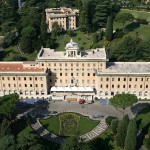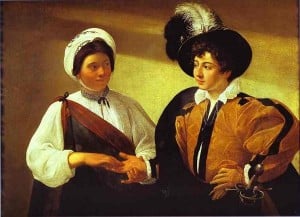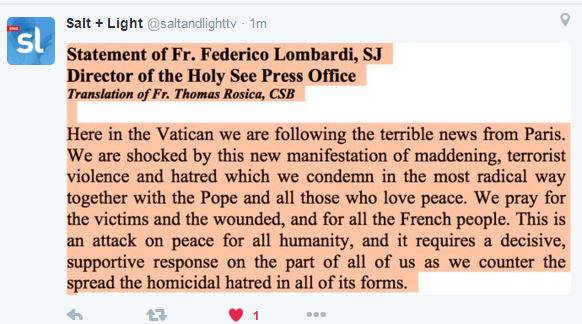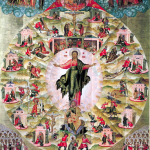 Were the uniforms of the Swiss Guard designed by Michelangelo? I’ve always heard that; but today I read–on the Vatican’s own website–that Michelangelo had nothing to do with it! Instead, it was Commandant Jules Repond, inspired by the frescoes of Raffaello, who had the inspiration for the iconic uniforms which are worn by guards in Vatican City and at papal events.
Were the uniforms of the Swiss Guard designed by Michelangelo? I’ve always heard that; but today I read–on the Vatican’s own website–that Michelangelo had nothing to do with it! Instead, it was Commandant Jules Repond, inspired by the frescoes of Raffaello, who had the inspiration for the iconic uniforms which are worn by guards in Vatican City and at papal events.
In any case, they are lovely, aren’t they? The bold blue, red and yellow stripes, the white of the collar and gloves….
Pope Francis spoke today about the celebrated uniform, in an audience with new recruits to the Pontifical Swiss Guard, accompanied by their families and friends. The new recruits will swear their allegiance to the Holy Father tomorrow. Pope Francis said,
“It is a special day, as it commemorates the Sack of Rome and the heroic act of your predecessors who, in 1527, offered their lives to defend the Church and the Pope. Your dedication confirms that their courage and loyalty have borne fruit.”
Speaking about the uniform, Pope Francis reminded the new guards that it’s not the uniform that sets an example, but the man who wears it:
“Its colors and shape are known throughout the world, and stand for dedication, seriousness and security. They are identified with singular service and a glorious past. However, behind every uniform there is a real person: with a family and a homeland, with a personality and sensibility, with wishes and plans in life.
Your uniform is an evocative trait of the Swiss Guard and attracts the attention of the people. But remember that it is not the uniform, but rather he who wears it, who must be noted for his kindness, his spirit of welcome, for his charitable attitude towards all.
Consider this also in your relations between yourselves, according importance, also in your community life, to sharing both joyful moments and those that are more difficult, without ignoring those among you who are in difficulty and who are at times in need of a smile and a gesture of encouragement and friendship. Avoid that negative distance that divides companions and, in the lives of all people in the world, can give rise to disdain, marginalization and racism.”
 The Holy Father went on to talk about changes which have come about since the uniform was first adopted, in the first decade of the 20th century:
The Holy Father went on to talk about changes which have come about since the uniform was first adopted, in the first decade of the 20th century:
“The social and ecclesial context has changed greatly since then. Society is different with respect to those times. But man’s heart, his capacity to be loyal and courageous–’acriter et fideliter’, as your motto says–has remained the same.
… Serving in the Swiss Guard means living an experience that involves a meeting of time and space in a very particular way.
… With your special service, you are called upon to offer serene and joyful Christian witness to whoever arrives in the Vatican to visit St. Peter’s Basilica and to meet the Pope. Live your days intensely! Be firm in your faith and generous in your charity towards the people you meet.”
 Lastly, Pope Francis encouraged the recruits to always share a smile, and to encourage others by their pleasant demeanor:
Lastly, Pope Francis encouraged the recruits to always share a smile, and to encourage others by their pleasant demeanor:
“Consider this also in your relations between yourselves, according importance, also in your community life, to sharing both joyful moments and those that are more difficult, without ignoring those among you who are in difficulty and who are at times in need of a smile and a gesture of encouragement and friendship. Avoid that negative distance that divides companions and, in the lives of all people in the world, can give rise to disdain, marginalisation and racism.
* * * * *
But more about Colonel Repond, whose fine taste for colors and shapes led to the stately uniforms which the Guard wear today. Repond, after studying and researching Raffaello’s frescoes, introduced the simple beret which, worn by guards still today, bears the soldier’s grade. He replaced the pleated gorget or throat-piece with a plain white collar. He improved the cuirass, the armor on the breastplate, and restored it to its original design.
The full dress uniform, used for special events, is worn with a special gorget (throat armor), white gloves, and pale grey metal morion (metal helmet) with ostrich-feather plume: white for the Commandant and Sergeant Major, purple for the Lieutenants, red for Halberdiers and yellow/black on a black morion for the Drummers. The Guards’ morion bears the oak of the Rovere family, a wealth Italian family from which come two popes: Pope Sixtus IV (1471-1484), who built the Sistine Chapel, and his nephew Giuliano (Pope Julius II, 1503-1513).
The Guard’s everyday uniform is completely blue.
* * * * *
What are the requirements for admission to the elite Pontifical Swiss Guard of the Holy See?
According to the Vatican website, an applicant must be:
- a Swiss citizen
- a faithful Roman Catholic
- of good moral ethical background
- between 19 and 30 years of age
- at least 174 cm (5 feet 8 1/2 inches) tall
- not married
- holding either a professional diploma or a high school degree
(Photos are from my own trip to Rome in 2003.)












